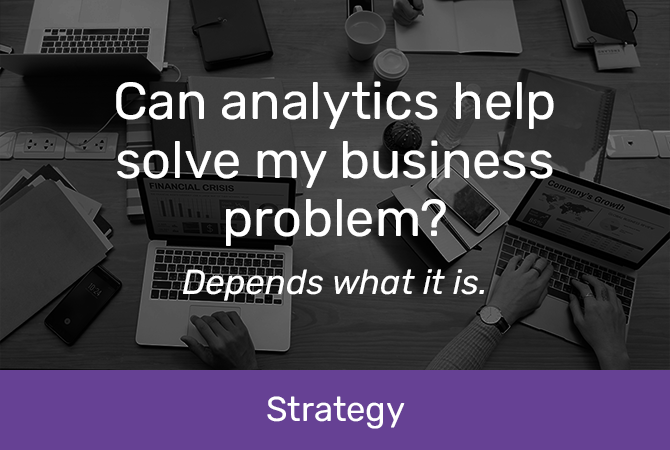Can analytics help solve my business problem?
Depends what it is.
Data analytics has the potential to be valuable for virtually all businesses, but not necessarily for all business problems.
As a result of the confusing rhetoric around the different definitions of analytics, we often have prospective clients coming to us unsure about whether or not their challenges are ones that a data deep-dive can solve.
Here at Datamine we pride ourselves on always being able to deliver a solution - but first the problem has to be clearly defined.
Four business problem questions to ask
If this is you, here are the questions you need to answer to tell if the business problem you’re facing can be addressed through the application of data analytics and data science.
![]() 1. Does the problem involve a business process that uses excel?
1. Does the problem involve a business process that uses excel?
Virtually all processes that use simple spreadsheets like Excel can be optimised through the application of analytics. This is especially true for important number crunching, like business forecasting – Excel isn’t an efficient long-term solution for business-critical analytics, so organisations that want to produce reliable, exact numbers should be using databases and modern analytical tools.
![]() 2. Does the problem involve inaccessible or siloed information?
2. Does the problem involve inaccessible or siloed information?
In many organisations, people come to meetings each wielding their own dataset and pointing to different numbers. Understandably, this can often lead to confusion, frustration and a lack of cross-organisational visibility. There are a number of analytical solutions that can help here, one of the best of which is the implementation of a CDP (also known as a datamart) where useful information can be stored and referenced by different parties across the business.
![]() 3. Does the problem revolve around a repeatable process?
3. Does the problem revolve around a repeatable process?
If there’s one thing analytics is always useful for, it’s automating repetitive and mundane tasks that don’t require human judgement. If you’re struggling to cut costs or improve efficiencies, the first place to look is at streamlining time-consuming processes that through automation - and potentially even AI down the road.
![]() 4. Does the problem feel too complex to solve with only the information you have?
4. Does the problem feel too complex to solve with only the information you have?
Analytics is often a last resort for businesses that are close to throwing their hands in the air and giving up trying to solve a problem that just seems too complicated to fix. The good news is that there are probably some answers within your data, regardless of what the crux of the problem is. Analytics can be used to solve issues across a myriad of different complexities, like sinking revenues, inefficient risk and fraud reporting, poor KPI management, plummeting marketing ROI and more.
These are a few areas in which analytics won’t actually be much help - they’re not areas that can be easily changed or optimised through data insight. If you’re struggling with regulation or policy challenges that are unrelated to your data governance, don’t worry too much about spending analytics time here – there will be lower hanging fruit!
Of course there are many more situations in which analytics can push the needle than the ones we’ve just described - pretty much any problem involving data or lack of understanding around why things are happening can be solved through the application of analytics.
Here a few examples of unique and complex challenges we’ve helped our clients solve through analytics:
Case study: Retailer saves over $100K per week through out-of-stock optimisation
- Challenge: A large retailer had suspicions that out-of-stock issues were having an effect on sales, but they struggled to justify investing more in distribution because the impact couldn’t be quantified.
- Solution: Datamine was asked to examine the problem, and by using demand-side analytics, we were able to provide a good estimation of the cost of out-of-stocks at a product and store level. This not only helped with the investment decision, but also highlighted the disparities in operational effectiveness between different stores.
- Result: The results of the double benefit were seen quickly, as the $80k analytics job rapidly delivered a net benefit of several hundred thousand dollars per week by improving stock availability and out-of-stock processes.
Case study: Entertainment business grows revenue by millions through data-mining
- Challenge: A large international entertainment business faced a significant year-on-year revenue decline from their loyalty base and had limited understanding of why it was happening – they therefore contracted Datamine to examine the problem in an exploratory piece of work.
- Solution: Datamine pulled thousands of variables and performed a comprehensive data-mining exercise, pinpointing that the problems were due to several seemingly benign strategic changes in product mix, promotions, staffing levels, and pricing.
- Result: Having specifically identified the issues, Datamine worked with the business to plan and execute a revised strategy which reversed the decline. The $60k project delivered a net gain of several million dollars of revenue over the following six months.
Case study: Insurer finds $10m locked in policy data
- Challenge: A large multi-national insurance company had concerns about the efficiency of its marketing efforts and approached Datamine about extracting data from its array of different systems – data which could then be applied to better inform its strategy around brand expansion and customer propositions.
- Solution: Datamine brought together a host of different systems and data silos into a single CDP, enabling a single customer view and identifying multiple opportunities. One entirely unexpected result was that Datamine uncovered millions of dollars in premiums which had not been charged, even though the policyholders were still being provided full cover.
- Result: The $80,000 project returned almost $10m to the company immediately and provided insights which led the insurer to establish an additional brand and associated product range in the marketplace.
















































